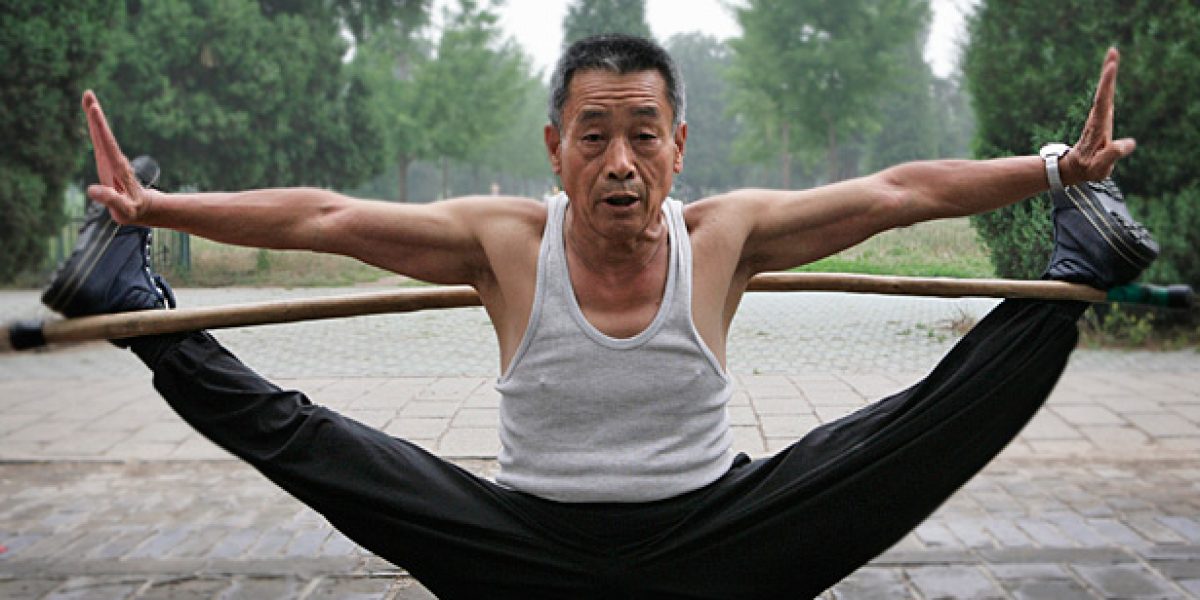The way we think about increasing flexibility and “stretching” needs to change because the common techniques used are an ineffective waste of time and can actually damage your tissues. The purpose of this article is to clear the air on why static stretching sucks and shouldn’t be done, the reasons why we get tight and inflexible and the logic behind safely and permanently increasing your flexibility. It’s not a how-to guide to stretching – I will finish by describing a muscle lengthening technique for the quadriceps as an example but teaching someone how to master their nervous system and increase tissue length requires time and detailed coaching beyond the scope of this article.
Why should we be flexible?
Although having too much flexibility can sometimes be a bigger injury risk than being tight; the majority of people need to increase their flexibility. Having tight muscles and being inflexible increases your risk of injury to both the muscles themselves and the joints above and below that muscle. Increased flexibility yields a buffer zone where you can put tension on a tissue without straining or tearing it. For example, tight hamstrings predispose to you a hamstring strain but also increase your risk of developing low back pain because of the muscles effect on the pelvis and therefore the spine. Most people stretch by holding a muscle on tension for a certain amount of time to make the muscle “longer” but techniques like this are laughable and ineffective. They do little to increase flexibility and can even damage your tissues. If knowledge is power then after reading the rest of this article you will be a powerful human when it comes to the logic behind the art of achieving flexibility.
Aging and inflexibility
FACT: As you get older 2 things happen: 1) you get weak, 2) you get tight. Healthy aging means doing something to manage both and to address #2 you needs to adopt a practice of increasing your flexibility and you need to do it consistently with appropriate techniques. A big reason we lose flexibility with aging is because of our reliance on tissue elasticity for flexibility. After a lifetime of built up microtrauma from activity, this elasticity is reduced substantially and with it goes flexibility. Here’s a little secret: there’s no exercise that can stop our connective tissues from aging so lets stop overstressing them with static stretches and learn how to master our muscle length by controlling our nervous system.
Traditional ineffective stretching
Here’s a stretch for most people: put a muscle at end range, spend time grimacing and struggling through uncomfortable tension for 20sec to a minute at your limit to help make it “longer”. What’s actually happening: the nerve running through the muscle is being put on tension and tells the brain to not let the muscle lengthen anymore (threat response), so you’re really just yanking away on your inert tissues (ligaments and tendons) – no wonder you don’t gain any flexibility that way. Traditional stretching fails because in many cases it assumes the tissues need to be physically stretched. Literally pulling on the tissues to force them to lengthen – its inefficient, damaging and a waste of time.
Unfortunately, this ineffective way of stretching has endured and is still taught in the fitness work and even by physical therapists (the fact that it’s still taught in physiotherapy school is ridiculous). There’s a better way to lengthen your tissues and gain flexibility and it’s far less painful and gives results in a much shorter timeframe.
Effective tissue lengthening
Here’s a new way of thinking about stretching: when you reach the end of your muscle length, that’s the point where the body feels it has to stop you or a potential injury could result, its not the full length of your muscle. Making it longer is more a matter of tricking your body into letting you lengthen your muscles to their full range than actually forcing the muscle tissue to lengthen. Effectively increasing flexibility involves mastering control over the command center of your body – the brain (aka central nervous system). Unleashing flexibility involves mastering control over your nervous system – doing the splits is less about lengthening the muscle and more about telling the brain its safe for your hips to enter that position without tearing anything.
Here’s a great analogy from Pavel Tastsouline’s book “relax into stretch” – a resource I used for this article and a highly recommended read. Think of your muscle as a telescopic car antenna – traditional stretching tries to forcefully stretch and lengthen the outer layer of metal to increase the antenna length. Mastering muscle tension by working with your nervous system means coaxing the inner layers of the antenna to elongate out of the outer sheath. Its quicker, safer and a much more effective technique.
Muscles: Tight vs. Short
Putting a joint in an inner range position for a sustained period creates a truly “short” muscle. It’s the result of a gradual contraction to a new resting length. Someone in a wheelchair that spends all of their time with their knees bent will develop short hamstrings over time. Short tissues are often not the main culprit for inflexibility although with people sitting so often these days it can sometimes be an element. The more common cause of inflexibility is “tightness” and poor tissue interface mobility.
Muscle “tightness” comes from your brain activating a muscle to give you stability – your nervous system makes you tight, not the length of your muscles or connective tissues. Learn to control your muscle tension through your nervous system and you can be as flexible as you want at any age. When you go into the splits, your limit of groin flexibility is usually a limitation artificially created by your nervous system based on what it perceives as a “safe” resting length of your tissues. Anything beyond that length is interpreted by the brain as a threat and prevented unless proven otherwise. The nervous system puts the brakes on your muscle length to keep you safe. Solution? Demonstrate to your muscles that they can lengthen and still be safe.
Another big element is tissue interface mobility and this is where tissue work like foam rolling can help achieve significant flexibility gains without even putting a muscle on tension. There are many different layers of tissue if you take a cross section from skin to bone of a certain tissue. Take the front of your leg for example – skin, fascia, nerves, 4 different muscle tubes (hence the name quad), more fascia, blood vessels, periosteum then bone. Even that is simplified and there’s a lot of different layers and all these layers are SUPPOSED to slide and move independently of one another. When the layers get laminated into a big block of tissue we lose a ton of lengthening capacity and working to separate the layers alone can yield increased flexibility.
Where to start
To begin your journey in achieving flexibility you need to start by determining which muscle groups are tight. Then, remove the word “stretching” from your vocabulary and replace it with “controlling tension”. Determining which muscles are tight and prioritizing which groups to start with to prevent injury is best done within a movement and flexibility screen by a competent physical therapist. To give you something to try right away, below is an image of the “couch stretch” – a position which allows you to gradually lengthen and master the tension of your front thigh muscle – the quadriceps. This one will be tight in almost everyone, give it a go.
The closer your knee is to the wall the more intense the stretch, start 30cm away and slowly work your way closer. Make sure your glute is squeezed and your pillar (aka core) is tight. Deep breaths from your stomach will calm your nervous system down and allow you to melt further into the stretch without your body fighting against you.
So, lets recap:
-Most people don’t stretch effectively. Learning to properly lengthen your tissues results in less time spent stretching and avoids damage to your tissues
-Getting older usually comes with losing flexibility. Work on it
-Increasing flexibility is more about convincing your brain to let your muscles relax and lengthen than it is about forcefully tensioning muscles to make them longer
-Unsticking the layers of your muscles with tissue work plays a big part in gaining flexibility
-Mutant flexibility is achievable. Learn better techniques and get better results
Hope this helps re-shape your outlook on stretching. Cheers
-Nick





